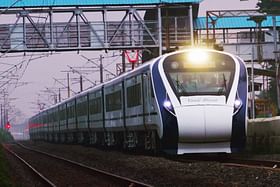Setting a target of laying 20,000 km elevated tracks, 4,500 km bullet train corridors and increasing the number of Vande Bharat trains to over 4,000, a massive expansion of infrastructure is being firmed up to meet the future need of India by 2047.
India will need around Rs 845-880 lakh crore investment between 2023 and 2047 in the infrastructure sector, to accelerate GDP growth, according to an estimate presented to the Council of Ministers on Tuesday (4 July).
It has recommended the roadmap for augmenting key infrastructure to meet the future need by setting the target to increase highway length by 1.6 times, port capacity by four times and doubling the railway network, including the laying of 20,000 km elevated tracks and 4,500 km bullet train corridors, in the next 24 years.
There is also a plan to take the number of Vande Bharat trains to 4,500 and fitting of Kavach, the indigenous anti-collision system, in all trains.
The estimates have underlined that nearly 56 per cent of the projected investment or around Rs 490 lakh crore would be required in upgrading the urban infrastructure, which includes laying around 5,000 km mass rapid transit system (MRTS) across 75 cities, compared to the current network of only 750 km in 27 cities.
According to the presentation, the focus would be on the central government using the Finance Commission and Centrally Sponsored Scheme (CSS) devolutions to nudge reforms in governance, planning and finances of the urban local bodies.
As per the roadmap, the government aims to achieve 100 per cent e-governance in all towns and digital property tax collection with regular assessments. It also sets the target to have at least one Indian city in the top 100 livable cities across the globe by 2030 and five by 2047.
Government projections estimate that the number of Indian towns with more than one lakh population would increase to 980 by 2040 and 1,500 by 2047. Now there are 770 such towns across the country.
According to the projection, faster and seamless mobility, reducing the logistics cost to 8 per cent of the GDP and reducing transportation time have been identified as the major thrust areas.


